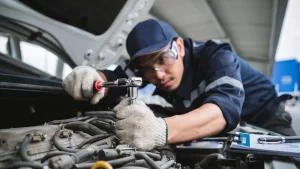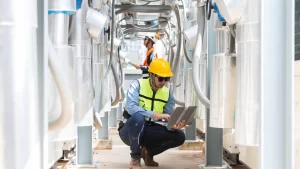On the Future of the Safety Profession
By Steven I. Simon, Ph.D.

The safety profession is at a crossroads. Today’s practitioner is definable chiefly as a repository of technical skills, but tomorrow’s safety professional will have to be both a technical expert and a change agent. What follows will examine the changed function, which is moving inexorably and rapidly towards a people-oriented activity.
The Business Case for Change in the Fundamental Assumption of the Safety Profession
Today’s organizations are in the midst of paradigm shifts that promise major changes in how people and work are managed. Safety management assumptions must change with them. To operate effectively, the safety function must redesign itself.
The emerging business paradigm is based on a set of new business assumptions that is already impacting the safety function. The mandates of the past – to organize hierarchically, to equate capital with power, to operate within national boundaries, to focus tasks around individuals – are giving way to a model that promulgates flatter organizations, equates knowledge with power, operates within a global marketplace and focuses tasks around teams.
Traditional reliance on safety engineering and identification of human error is no longer sufficient to achieve increasingly higher safety goals. Tremendous cultural changes are taking place right now in our organizations, and the safety profession will have to change to keep up. Table 1 links elements of the new business paradigm with the changes the safety profession will have to make.
| CHANGES IN BUSINESS PARADIGM | PAST ASSUMPTIONS OF THE SAFETY PROFESSION |
NEW ASSUMPTIONS OF THE SAFETY PROFESSION |
|---|---|---|
| |
||
|
||
The Safety Professional as Agent of Behavioral and Cultural Change
Changing profound individual and organizational assumptions actually amounts to changing culture because assumptions drive behavior. Organizational assumptions drive organizational behavior: assumptions influence the frequency and intensity of both safe and at-risk behaviors. Consider, for instance, the assumption that productivity is more important than safety. This assumption drives a host of unsafe behaviors. Guiding the emergence of a new assumption (that safety and productivity are equally important) to dominance will be the role of the safety leader of the future, who will be as comfortable identifying “cultural hazards” and developing culture change strategies as s/he now is with spotting and remediating physical hazards. Competency in the arena of culture change is critical to the core definition of the safety profession.
It is imperative for the safety professional to understand how culture affects organizations and to understand its impact on safety performance. A supportive company safety culture based upon new assumptions is key to achieving breakthrough safety performance. Without a supportive culture, even the best designed safety processes or programs will fail. The deepest root cause accident investigation technique will be stumped and stopped in its tracks by a mistrustful, cover your back, blame-the-other-guy culture dominated by norms of concealment.
Clearly, in order to be an agent of behavioral and cultural change, the safety professional will be a leader, s/he will be enterprise-centered and able to make safety a value-added function, and s/he will take advantage of educational enhancements to stay on the leading edge.
The Safety Professional as Socio-Technical Leader
Looking at organizations as socio-technical systems means recognizing that the culture influences the way work is done and vice versa. The social systems include trust, collaboration, communication, and working in teams, to name just a few elements. The technical systems include operations procedures, equipment calibrations, and policies. The best technical systems in the world will fail if the social systems are dysfunctional. Where the technical systems and socio-cultural systems overlap is the point where synergy creates the highest productivity, quality and safety.
High accident frequency rates and workers’ compensation costs correlate with low employee ratings of the safety culture in perception surveys. These surveys measure such soft issues as belief in management commitment to safety, trust, caring and communication. In fact, management efforts to resolve safety maintenance and engineering problems tend to go unnoticed, according to perception surveys, when employees feel that genuine commitment or caring is lacking.
When accident causation is regarded as a function of deficiencies within the total socio-technical system, the case for organizational change is unarguable. And when the mission of changing the safety culture is delegated to the human resource staff rather than owned by line management in partnership with a safety professional in his/her role as champion of change, the case for safety will remain a step-child. The stage is set for authentic change only when those who have always championed an injury-free workplace exercise their initiative, commitment and know-how as leaders and partners.
The safety profession of the future will depend upon leaders who can transform the behavioral and cultural arenas of their organizations. Transformational leaders are those who can create, communicate and implement a new vision, who care enough to change themselves first, so they can inspire others from their own inner values and convictions. Such leaders will see the development of shared beliefs, attitudes and unwritten rules that will drive safe behaviors through the organization as critical to achieving an injury-free workplace. They will understand that it is part of their job to deploy sustainable employee and management expectations, assumptions and behaviors as critical elements of a culture-based safety process that must be in place to create and sustain a positive safety culture.
Transformational safety leaders must utilize a comprehensive framework to analyze the systems, culture and structures that affect performance. They cannot rely on single-factor methods or theories. Essentially, the professional safety leader of the future will have the responsibility of instilling in others the capability to create common values, language and assumptions around safety goals and expectations and how they might be successfully achieved in an organization. It will be commonplace for them to:
- Involve employees in identification of desired behaviors, norms and assumptions.
- Use perception surveys to discover gaps between present behaviors, norms and assumptions and the desired ones.
- Develop a plan to change, improve or maintain safety performance once needed cultural changes are identified.
Changes to organizational systems can include:
- STRUCTURE – policies, procedures and formal communications.
- TECHNOLOGY – how we work, work flow, type or design of equipment and job structure/design.
- REWARDS – extrinsic rewards (e.g. bonuses or incentives) and intrinsic rewards (job satisfaction, personal health).
- MEASUREMENT SYSTEMS – transition from consequence-based measures (injury statistics or related injury costs) to proactive or preventive measures that reduce hazards and risks.
- SOCIAL PROCESSES – informal communication systems, degree of employee empowerment and participation, conflict resolution, openness and trust.
Being Enterprise-Centered
Safety practitioners who become transformational leaders in enterprises pursuing change have what it takes to spell out clearly the secrets of engendering safety culture to an organization, and the courage to share ownership of the change process. “They [must] see their role as creating awareness in their employing enterprise, building an effective safety infrastructure and forming a culture where safety is part of the operation of management, rather than a separate entity put there because the law requires it”.
In order for the safety professional to form a culture where safety is part of the operation of management, s/he must move beyond the familiar comfort of safety, traditionally separate positioning, and listen to the surrounding environment. As the socio-technical system model begins to evolve, roles start to change. All professionals become interactive teammates with line management rather than individual players.
The safety professional can and should expect to be able to report to the top of the organization. By positioning the function as enterprise-centered, safety can be projected as value-added. By being constantly aware of the broader organizational community of which safety is a part, the enterprise-centered safety professional is in a unique position to align with top management on shaping the total organizational culture.
Being on the Leading Edge
Being on the leading edge means knowing what is at the forefront of modern theories, what is practical, what is working. As life gets more complicated and more costly, organizations will want to implement the most cost- effective (not necessarily time-sensitive) programs. Armed with an understanding of safety culture, practitioners can better identify areas in which their efforts will have the greatest impact. Every change event will have HSE impact. The safety professional will be charged with ensuring occupational health and safety is advanced rather than jeopardized.
As a champion of change, the new leader must think globally and be able to work different jobs. Most importantly, he must understand the evolution taking place in his own field, support it, and communicate it to other people, namely the managers whose duty it is to diffuse it throughout their organization. Safety is neither about technology nor behavior. It is about those things along with culture.
Education
Thus, the safety professionals of the future will need to be able to develop accident prevention strategies that address technical needs, but include organizational development strategies for implementing the technical changes as well. Obviously, the skill set to deliver the socio-technical systems change for safety such as core competencies of behavioral sampling and culture change methodologies will require different professional education from what is currently offered.
There is a need for business savvy if he or she is to help managers translate business trends into safety initiatives, programs and training. There is a need for an understanding of the behavioral sciences in order to make recommendations to align and prepare the people for upcoming changes. Furthermore, the professional safety leader of the future will have the responsibility of recognizing and creating common values, language and assumptions around safety goals that will help the organization survive competitively. Finally, the rapid changes in technology require the safety professional to participate constantly in currency training.
Right now, there is a lack of safety, health or environmental college curricula for business or management students. Business/management students need to learn about safety and culture change. Safety students need to learn business and management. Unfortunately, many new educational programs are still developed without adhering to the established standards that lead to accreditation. Today there are only 14 safety programs accredited by the ASSE.
Job Description of the Future
It might be helpful to conceptualize the above characteristics within a framework of a hypothetical job description that emphasizes both the social and technical aspects. Creating and maintaining an injury-free workplace is simple in theory but difficult in practice. Seeing the major points of this paper presented in a traditional form might serve as a more concrete blueprint for pursuit of an injury-free future. Such an example is presented below.
Job Title: Safety Professional of the Future
Basic Function
- Develop an integrated, corporate-wide system approach to injury and illness prevention and compliance assurance that emphasizes both technical and human organizational
issues. - Develop strategies, standards, and solutions for occupational injury/illness prevention, regulatory compliance assurance that emphasizes technical, behavioral, and organizational issues.
- Partner with company leadership to develop a culture where all employees assume personal responsibility for safety and where safety is integrated into business activities.
- Establish and implement strategic educational and training programs which will improve knowledge of potential health effects, safety procedures, and the role of the employee in the safety process.
Technical Skills
- In-depth knowledge and experience in direction and management of health and safety processes.
- Demonstrated knowledge of occupational safety, occupational hygiene, ergonomic, and related regulatory and educational systems; their interrelationships; and their relationship to related areas.
Socio-Cultural Skills
- Able to lead a change in both the technical and the human organizational arena by shaping a vision; mobilizing commitment; monitoring progress; recommending modifications to measurement, recognition/reward and communications systems for lasting change. Able to partner with line management in implementation of change efforts.
- Lead own staff and model behavior in a style that demonstrates the corporation’s participative and empowerment goals.
- Able to build collaborative relationships with business leaders while maintaining high safety standards. Capability to relate closely with leadership, staff, worker representatives, and operating management to advise and counsel on matters relating to developing a positive culture, planning, measurement and implementation of occupational health and safety processes.
- Knowledge of organizational analysis skills needed to conceptualize, design, and implement a socio- technical systems approach to occupational health and safety processes.
- Able to develop skills in others so they can lead change and integrate it into existing business activities.
- Able to communicate principles and standards in a way that gains support from all levels of the organization.
Conclusion
The safety professional of the future must be able to revitalize a sense of community. Changing profound assumptions – personal and organizational – is a difficult and long job. It will require leaders at all levels – company, union and worker alike – to model behaviors congruent with the precepts they put forth, as well as education to keep the desired safety values, beliefs and culture central to every work process. Many organizations just aren’t ready for this type of approach. Because this is a philosophical evolution, this professional will also need the patience and faith to stick out the long term positive effects of cultural change. Demand for these services will eventually increase as enterprises realize the benefits. Remember, “You can lead, follow or get out of the way.” Each has its place in the world of safety.
Addendum I
OSHA Star Plant S&H Supervisors Examine their Future Role
The need for a new role is gaining wide acceptance within the ranks of safety professionals as shown in the following data. In 1993, I conducted an all day conference with 83 safety and health supervisors from plant sites that had been awarded OSHA STAR status (STAR status is granted to organizations that meet a rigorous OSHA 2 week on site examination of systems, procedures and employee participation). They were asked to describe the role for the S&H supervisor for the year 2000 and beyond. After an in depth examination of the then and future business, regulatory and social forces influencing the area of safety and health, they redesigned their job descriptions to fit the future needs of their customers. The following descriptions achieved consensus within the group.
The job title will change to include the word “advisor”. The role of safety supervisor will change from doer to facilitator. Line management will drive safety efforts, employees will implement and the safety professional will advise and facilitate. Suggested names were facility safety advisor, S&H systems analyst, ES&H and logistics advisor.
Responsibilities will include:
- Facilitating the safety process which includes the S&H management systems.
- Becoming a business partner, which means understanding financial and accounting procedures, production standards and quality, how standards are set and organizational planning.
- Understanding management and employee needs for the 21st century.
- Risk assessment.
- Cost Analysis.
- Salesmanship, which means being able to sell safety programs & procedures.
Partnering and interpersonal skills, which means being able to build trust, facilitate openness, break through barriers and misconceptions.
Skills training to fulfill the above responsibilities included:
- Department rotational assignments
- Time management
- Systems skills
- Effective communication
- Statistics
- Facilitator skills
- Behavioral observation
- Team building
- Organization design skills
- Political / Interpersonal skills
- How to set performance measurement criteria
- Computer skills: programs/software
Attitudes/Assumptions required:
- Acceptance of role as facilitator, not doer
- Must have employee and management buy-in to succeed
- Team player
- Realism
- Management as customer
- We can improve
- Change is necessary
- We can influence change
- Have management commitment
- Openness, willingness
- Looking for opportunities to partner with management
As stated earlier, we indeed are at a crossroads. Some safety professionals may still succeed defining themselves exclusively as technical experts, but as this significant collection of safety supervisors has indicated, business demands are pushing them into the role of both technical expert and change agent.

Professional Safety





